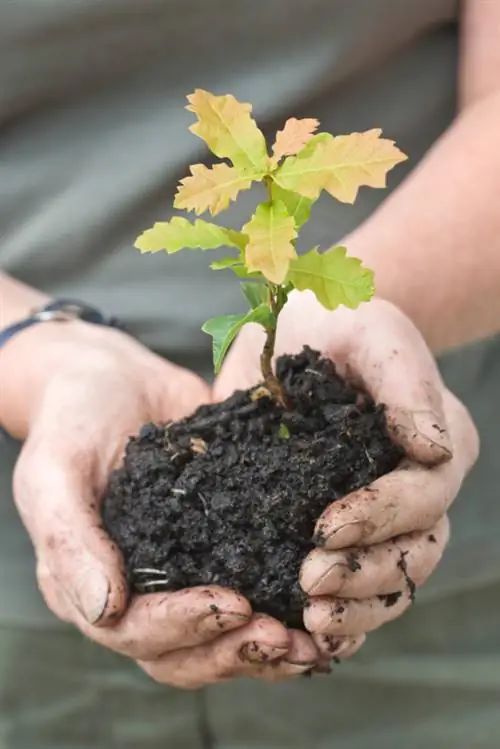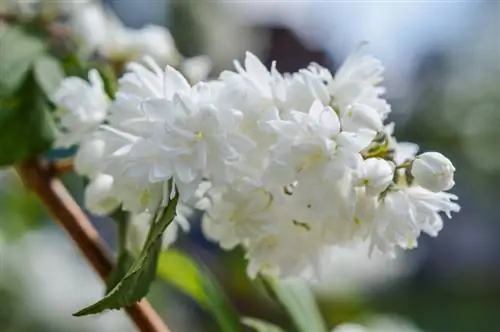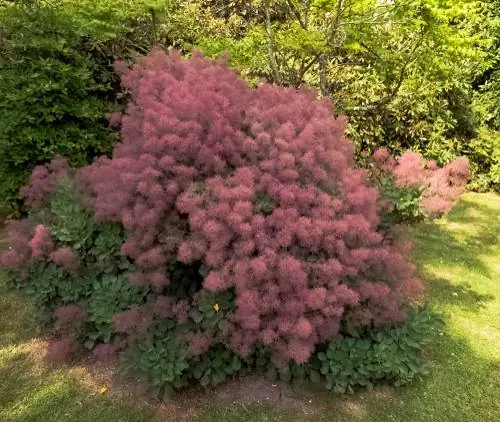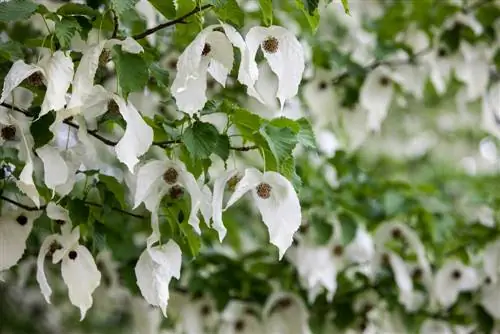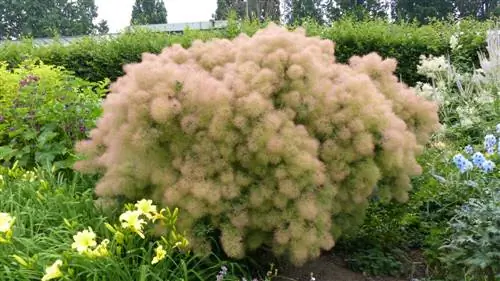- Author admin [email protected].
- Public 2023-12-25 17:45.
- Last modified 2025-01-23 11:22.
With fluffy fruit heads and magnificent foliage color, the wig bush in the garden ensures a furious end to the season in autumn. In order for the impressive ornamental tree to thrive in beds and pots, it only requires a little gardening attention. Open questions about cultivation receive a practical answer here.
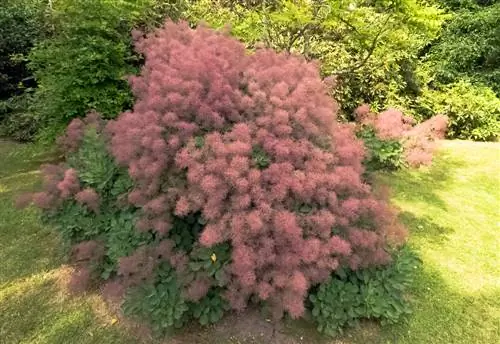
How do I properly care for a wig bush?
A wig bush thrives best in a sunny, warm location in well-drained, nutrient-rich and slightly calcareous soil. The optimal planting time is September and October. Regular watering, monthly fertilization and annual pruning in spring promote growth and flowering.
Planting Peruvian shrub correctly
With professional planting, you lay the horticultural foundation for the brilliant autumn spectacle of a wig bush. The optimal planting time is September and October, when the soil is deeply warmed by the sun's rays. While you prepare the clod until it is finely crumbled, the still potted root ball is soaked with water until no more air bubbles appear. The perfect planting pit is twice as large in diameter as the root ball and corresponds to its height in depth. Follow these steps:
- Enrich the excavation with rock dust (€18.00 on Amazon), horn shavings and compost
- Heavy soil becomes more permeable with the help of a few handfuls of quartz sand
- Insert the potted root ball and bury it so deeply that it is flush with the soil
Tamp down the soil and water abundantly on the day of planting and afterwards without causing waterlogging.
Care tips
It is a clear schedule that sets the direction for proper care. In order for the wig tree to feel at home and thrive, these donations are important:
- Water the ornamental tree with normal tap water when it is dry
- Monthly fertilizing with compost or nettle manure is beneficial from April to August
- Nitrogen-concentrated complete fertilizer impairs flowering and decorative fruiting
- Stabilize the pH value to 7 and higher with the help of one or two doses of garden lime
- Mulching with leaves, grass clippings or bark mulch keeps the soil warm and moist
- Annual thinning in early spring and pruning only if necessary
The wig tree only requires light winter protection in the first two years outdoors. When grown in pots, we recommend moving the plant to frost-free, dark winter quarters. Alternatively, wrap the bucket in foil and place it on insulating material such as Styrofoam or wood.
Which location is suitable?
The wig tree develops its optimum in a sunny, warm and protected location. The ornamental tree also tolerates a partially shaded location, although its habitus falls short of the high expectations. Its demands on soil conditions are limited. As long as it is normal, well-drained garden soil with a light to medium lime content, the sumac will happily spread its roots. The plant cannot get used to strongly acidic soil.
The correct planting distance
In a solitary position, a wig tree stands out impressively. Therefore, plant one specimen per square meter. If the ornamental shrub functions as a decorative hedge, the planting distance should be 100 cm.
What soil does the plant need?
The wig tree feels at home in common, well-drained garden soil. Ideally, the substrate is rich in nutrients and has a medium lime content. In particular, there should be no risk of waterlogging, so close proximity to a body of water should be avoided. In contrast, the ornamental tree is remarkably drought-resistant, which makes it easy to position in the sun-drenched rock garden.
What is the best time to plant?
In the sun-warmed, autumnal soil, you provide the wig tree with first-class starting conditions and a vital growth advantage for the first season. If the ornamental tree is planted in the ground during the months of September and October, there are good prospects of flowering in the first year. Another time window for planting opens in spring, as soon as the Ice Saints have said goodbye.
When is flowering time?
The period of rather inconspicuous flowering extends over the months of June and July. In protected locations it sometimes starts as early as May and does not end until August. Depending on the variety, the flowers develop in a subtle, yellowish color or in a pink to purple shade. Although the flowers grow less conspicuously, the spectacular development of the fruit clusters with their wig-like hairs does not take place without their preliminary work.
Cut the Peruvian bush correctly
In general, the wig tree develops a harmonious silhouette without any gardening intervention. Since the tree can reach impressive dimensions if well cared for, pruning is still an option due to a lack of space. Since a Cotinus coggygria is pleasingly tolerant in this regard, proceed as follows if necessary:
- Thoroughly thin out the wig bush between February and April
- Short branches that are too long to the desired length
- Make each cut 2-3 mm above an outward-facing knot
In addition, a wig tree can tolerate a radical pruning of half to two thirds. In this case, this year's blossom and with it the fluffy wig costume in autumn falls by the wayside.read more
Watering Peruvian bush
Water a wig tree not according to a fixed schedule, but generally as needed. Only when the soil surface has dried to a depth of 3-5 cm is watered with normal tap water. This may be required every 2-3 days during dry summer periods and every 1-2 weeks or even less during a rainy spring. Apply the water directly to the tree disc using the garden hose or watering can spout to avoid sprinkling the flowers and leaves.
Fertilize Peruvian shrub properly
Although the addition of fertilizer is not absolutely necessary in nutrient-rich and calcareous garden soil, a wig tree is grateful for the following extra dose:
- Spread a nutrient-providing layer of mulch, such as autumn leaves or grass clippings
- Fertilize every 4 weeks from April to August with compost or nettle manure
- Apply a liquid fertilizer for flowering trees in the bucket
Avoid using nitrogen-rich complete fertilizer because this oversupply promotes leaf growth while flowering and the resulting, eye-catching fruit cluster are left behind. If the growth performance falls short of expectations, adding garden lime is more likely to solve the problem.
Diseases
If the leaves hang limply and entire branches die, it is likely that verticillium wilt has struck. First check whether drought stress can be ruled out by watering extensively. If the damage does not improve, the fungal spores Verticillium albo-atrum and Verticillium dahliae clog the supply pathways in the wig tree. Immediately cut all affected branches back to he althy wood. Additionally, dispose of all fallen leaves in the trash. With a bit of luck, the plant will recover in the early infestation stage. Otherwise, the wood must be cleared over a large area in order to prevent this infectious disease from spreading further in the garden. Effective control agents have not yet been developed.
Wintering
A well-established wig tree can get through the cold season on its own. Only in the first two years and in the bucket should you take the following precautions for he althy wintering:
- Cover the tree disc with autumn leaves, straw or a thick layer of needle twigs
- Wrap the young crown and trunk with jute ribbons
- Cover a bucket with bubble wrap or bubble wrap and place it on a wooden block
- Water a little every now and then when there is frost
In the pot there is always the risk that the root ball will freeze. If in doubt, the wig bush should be moved to a frost-free winter quarters that can be dark before the first frost. Only water the tree enough to prevent the root ball from drying out and do not apply any fertilizer.
Propagate Peruvian bush
If you would like more specimens of the spectacular ornamental shrub, you can choose from the following methods of propagation:
- Pull the sinker to the ground, bury it in the middle and let it root until next year
- In winter, cut several 15-20 cm long cuttings and plant them in lean substrate
- Sowing seeds behind glass from February
How do I transplant correctly?
You can safely transplant a wig tree within the first 5 years. For this measure, choose a frost-free day during winter rest. Beforehand, cut the shoots back by about a third to compensate for the loss of root volume. Following the transplanting campaign, an extensive water supply is of utmost importance for vital root formation.
Peru corner bush in a pot
So that a wig tree can thrive in a pot, knowledgeable breeders have produced small-growing varieties such as Young Lady. Choose a planter with a minimum volume of 30-40 liters and use a nutrient-rich and well-drained substrate. The addition of vital lime or rock powder ensures the required lime content. Drainage made of pottery shards or grit over the water waste is essential so that waterlogging cannot occur in the first place.
Is Peruvian bush poisonous?
Classified as a herbaceous plant and due to its botanical relationship to poison ivy, it was long suspected that it contained poison. Extensive field tests have now proven that a wig tree poses no he alth risk to humans or animals.
Peru corner bush not blooming
There are various reasons why a wig tree does not bloom. The following brief overview gives the most common triggers for the dilemma with tips for clearing them up:
- Unsuitable location: move to a sunny, warm place
- Waterlogging: Water less and, if necessary, transplant into permeable, loose soil
- Too acidic soil: test the pH value to lime the wig tree if the value is below 7
In the first two years, a wig tree also takes time to become firmly rooted in the ground. If the shrub is propagated by hand by sowing, it will take 3 years or more until the first flowering occurs. So be patient until a young plant blooms for the first time.
Beautiful varieties
- Golden Spirit: The variety impresses with golden yellow foliage that turns reddish in autumn; Growth height 200-250 cm
- Royal Purple: Magnificent wig tree with black-red leaves and feathery fruit heads in autumn; Growth height 300 cm
- Young Lady: The compact shrub impresses with white-pink flowers from the end of May; ideal for the pot thanks to the 120 cm growth height
- Grace: Majestic new breed up to 4 m, with purple leaves, dark pink flowers and dark red wigs in autumn


